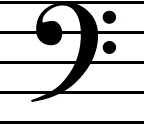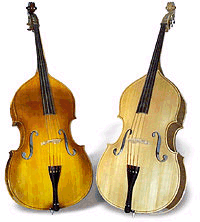|
 |
|||||
 |
 |
||||
|
The Resolution loudspeaker has a unique bass characteristic; the bass is gradually attenuated from 500Hz to 20 Hz without the usual uneveness. Having the bass roll off, can be deceptive as first impressions suggest that there is 'no bass' - in fact what most inexperienced listeners are missing is the boom artificially generated by speaker vibration or the crude exaggeration of a tuned band by use of a front or rear reflex port. Practically it is silly anyway to create a loudspeaker that has a completely flat bass since power required from the amp is inversely proportional to frequency, and the displacement of the cones would be in inches at 20Hz for typical listening levels.The 'kick' played by most loudspeakers is tuned around 300Hz but gives the listener the impression of a much lower frequency by mental association with the drum beat's important harmonics. 60-90dB (@1m) is a typical sound level for hifi, but 90dB of Bass at 30Hz would require over ten times more power to achieve than 90dB Bass at 300Hz. Most hi-fi amplifiers are designed to be running at 5-15W not 50-150W. Incidentally 90dB Bass at 30Hz will probably be rattling your windows, teeth, and your neighbour's windows and teeth if you share a wall! Generally music when recorded is always higher than 30Hz, anything lower is likely to be a low-fi air movement or seismic origin, but there seems to be 2 common exceptions which I will describe, but please understand that these are extreme and particular to live bands. 1.An electric bass guitar, played through a powerful 12/15 inch rock band PA sounds quite unique. The large cone becomes the instrument, instead of the string itself, and much LF sound emerges as the sound is heavily coloured by the airflow turbulence, and not just the original signal - amplified. A reflex or vibrating cabinet may recreate this turbulent sound quite well at low volumes, but will be hopeless at recreating unadulterated tones and instruments - especially within multi-instrument arrangements at higher volume. 2. A Bass Drum is largely moving air as well as making a low note, and to recreate this sound is beyond most band's PAs let alone a hifi that is supposed to fit into a lounge! to
recreate not only the sound but the movement of air you would probably need a cone the same diameter as the drum itself - to be precise enough. Of course most people are happy with any sort of 'kick' sound to
keep their foot tappin' to the music and again exaggerating a tuned band can appear to be improving 'the bass', but in fact is just losing control of the backwave at certain frequencies. If the loudspeaker is
designed to lose control progressively in the bass end - it will result in a flatter bass roll off, but you dont get something for nothing - the tightness, detail, and fidelity of the bass is lost.
To understand the bass performance of a TL, you have to see it in the context of other (cheaper) designs Most loudspeakers fall into 3 categories: Reflex / Infinite Baffle / TL Reflex designs always have imprecise bass at most bass frequencies because of interference Infinite Baffle suffer massive cabinet vibration,weak or non-existent bass, and very restricted dynamic range (loud/quiet ratio is reduced) TL have unrestricted dynamic range, and low distortion, but you only get out the driver's performance - which will naturally have a diminishing bass curve. We now compensate for this curve with the equalizer unit, so there is now no down side to a single-drive unit (fairly literally) to overcome the bass loss, most manufacturers add a second driver(woofer) and crossover unit - this ruins realism and efficiency. with a SUHTL, it is necessary to add a little bass boost, using the equalizer supplied, connected easily to your amp. Because purists may argue that tone controls add distortion - this digital unit causes no detectable hiss or distortion, compared to the massive distortion a crossover and woofer would have caused, that we dont have!
The Resolution is not a loudspeaker for everyone's taste, because it doesn't have the 'boom boom' of a reflex or the techy' looks of multiple tweeters and woofers spread around. It is quite heavy at 26kg ea and 900mm tall make it unsuitable for bookshelf or wall mounting. Dont forget this is the loudspeaker you have all been waiting for... a 23Hz Transmission Line in sensible compact form that hasn't lost it's bass, no crossover, dynamic, powerful, incredibly clear and undistorted. Finally - if you want more boomy bass - try using a subwoofer, I can honestly say that it will 'blow your neighbours away' (right through the adjoining wall in my case) . Seriously though a subwoofer will enable you to enjoy rock'n'roll and home cinema to greater effect. This is because those types of 'live' performance generated bass movement in the league of 50watts or more live, and to ask a small cone to do this is destructive. If you must endure shuddering bass, dont ask a loudspeaker to do a job only fit for a P.A. or dirty great guitar amp did. most people listen to hifi at far less volume than the live performance was, and loudspeakers should reproduce bass too at those reduced levels, but if you are throwing a party and want to recreate the levels of a live band - get a sub or hire a P.A.
|
| [Resolution] [Product] [Sales] [Advertisements] [Forum] [Reviews] |
|
Please contact our Webmaster with questions or comments.
|

